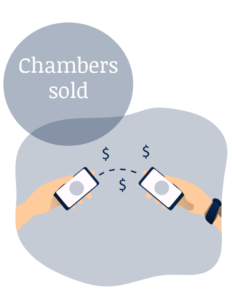A guest article by Law Business Managing Partner Alexander Gendlin in LTO.DE on the topic “How big do marketing budgets have to be?”
Law firm managers are often puzzled about how much money they should spend on marketing.
Are you one of those law firm partners who regularly receive extensive mandates for years without any marketing activities? And are you absolutely certain that these sources will never dry up? Then you can stop reading this article with a clear conscience. For everyone else, one question arises again and again: Am I spending too much or too little on my marketing activities?
Basically, four different approaches to calculating marketing budgets can be observed in law firms, with marketing being used here as a collective term for business development, advertising and public relations.
On the one hand, there is the “subjective expenditure” method: in this case, the law firm simply asks itself: “How much can I afford to spend on marketing?” Small law firms mainly use this method, and it has one significant advantage: it takes very little time.
The disadvantage: it is a flawless waste of money and time and does not even show any effect in the medium term. After all, the market cares little about how much a law firm can afford.
Such an approach usually results in the famous advertisement placed once a year or a Google AdWords campaign in which a mini-amount is placed on “lawyer” or “lawyer in legal field XY” with a high level of spiritual trust.
Before using such a method, I recommend leaving it at that. If there is any effect at all, then it isn’t very important. The money invested is guaranteed not to be matched by new acquisitions.
The “revenue share” method is also very popular. In this case, a certain percentage of the current or future law firm turnover is allocated to marketing expenses. In the legal sector, by the way, this percentage is relatively low at 1 to 4.5 percent, although it is increasing. In comparison, the cosmetics industry, for example, spends considerably more on marketing, at 40 to 45 percent of turnover.
Cosmetic products are, of course, much more accessible to compare with each other and, therefore, require much more advertising emotionalization to differentiate them. Nevertheless, the marketing expenditure of law firms is still far too low in comparison.
The advantages of the revenue share method are a certain continuity of expenditure, a satisfied Chief Financial Officer, and a certain proportionality to competitors. Not to forget the positive effect of law firm management having to actively address the question of what to do with marketing.
However, the main disadvantage of this watering can method is that no distinction is made between individual areas of law and market, and product cycles are ignored completely.
For example, in a saturated market, a much larger budget is required to advertise legal services that have been around for a long time and only produce stagnating sales than for introducing new legal services in a young market. This is because in a young market, there are fewer competitors with whom you have to fight for the attention of clients and multipliers in terms of marketing.
Next, the “Me Too” method should be mentioned, which is very similar to the sales share method. With “Me Too,” the shrewd marketeer looks at competitors’ budgets. In other words, they all copy each other, and you can only hope that at least one of them has done a solid job. This method usually results in unnecessary costs because, with a few exceptions, no two law firms offer precisely the same range of services.
For example, if it would make sense for a law firm focusing on M&A and capital markets to invest in expensive advertisements, it may make less sense for a law firm of the same size focusing on tax law. Even one-person law firms that offer the same area of law have different strengths and cannot be placed on top of each other 100% congruently.
So what to do? My recommendation is the “individual target-oriented” method. Here it would be best if you first defined clear goals for all areas of law, for example: “The Real Estate practice group is currently generating too little turnover and should be promoted with marketing measures XY. The aim is to increase turnover by ten percent by the end of the year.” The budget can then be drawn up accordingly based on the desired increase in turnover. Of course, this requires information on the marketing costs incurred to date in the real estate sector.
This method can be used by both large and small law firms. The latter in particular, like to do a lot on their own and have very erratic marketing decisions and expenditures if they do not set themselves specific targets. Of course, goal analysis and goal setting are less complex in smaller units.
The advantage of this method is that the law firm is often aware for the first time of the marketing goals it wants to achieve. The disadvantage of such a method is that you must invest a lot of time in defining the right goals. But this is necessary, because: Being the first to reach the wrong target will at best, benefit your competitors.
Alexander Gendlin has been working in the legal sector since 2004 and is the owner of the consultancy “Law Business, Business Consulting for the Legal Industry” (lawbusiness.de). Gendlin is a C. H. Beck author and lecturer at the Vienna University of Economics and Business JUSPLUS Business Law









